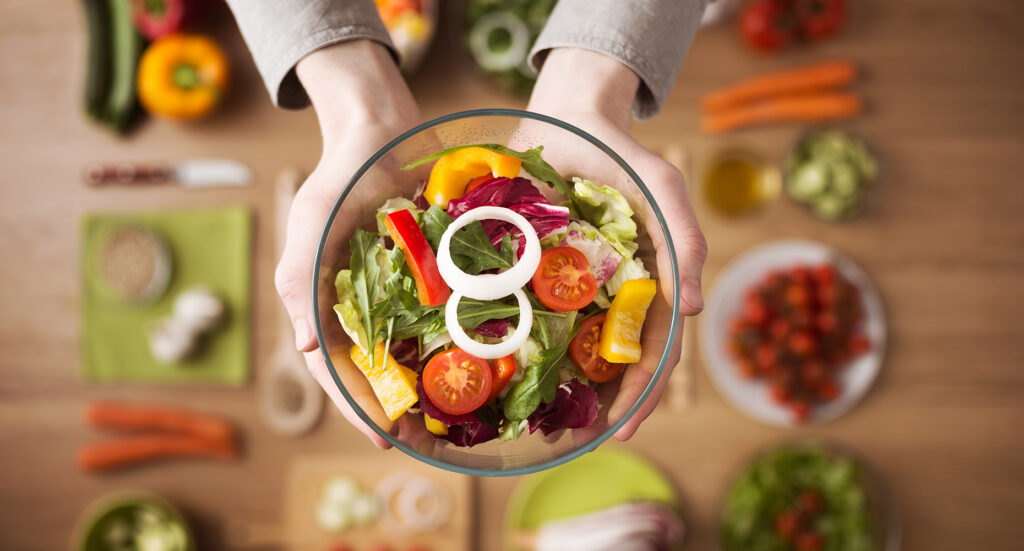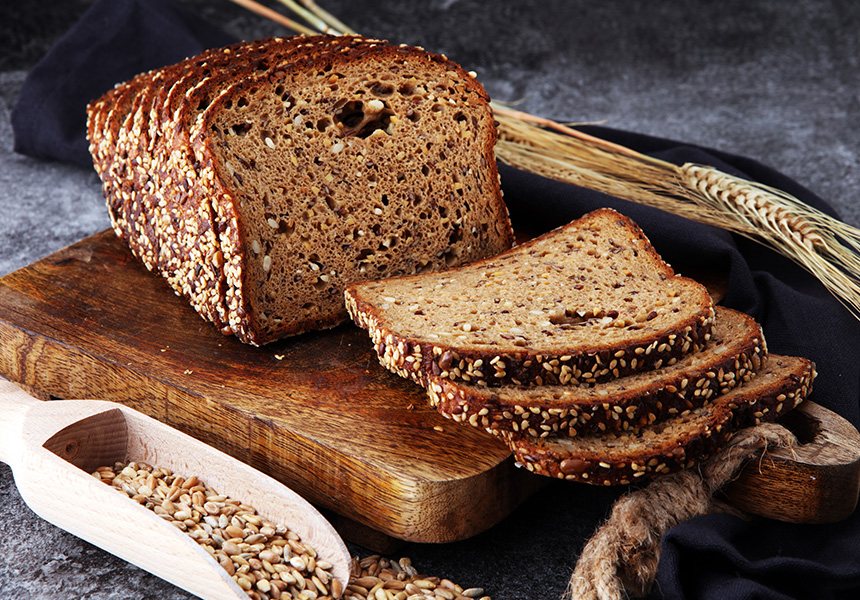Eat Right to Fight Diabetes
It can be difficult to stay on the healthy eating bandwagon now that summer’s here. After all, you’ve got county fairs, long-overdue vacations, and get-togethers with friends and family that you’ve been waiting eons for ... all with admittedly delectable, but often not too healthy, fare at your disposal. There’s even a National Junk Food Day to contend with!


Eat Right to Fight Diabetes
June 20, 2021
.
It can be difficult to stay on the healthy eating bandwagon now that summer’s here. After all, you’ve got county fairs, long-overdue vacations, and get-togethers with friends and family that you’ve been waiting eons for ... all with admittedly delectable, but often not too healthy, fare at your disposal. There’s even a National Junk Food Day to contend with!
And while it’s fine to enjoy less-than-healthy foods now and then, it’s important not to make it a habit, especially considering the fact that diabetes — along with a major contributor to the disease, obesity — have become epidemics in this country. To balance out the occasional indulgence, it pays to eat a healthy, well-balanced diet most days, and one that will help head off both of these health risks.
Read on for some of the best ways you and your patients can structure your diets to help prevent diabetes, along with important facts about the disease. (Note: While rates of Type 1 diabetes have also increased dramatically, particularly among young people, we’ll focus on the more common form, Type 2, here.1)

What’s Driving the Epidemic
It’s no secret that the number of diabetes cases has skyrocketed over the past few decades. What may be less well known is just how many people have been diagnosed with the disease: According to a 2020 report from the Centers for Disease Control and Prevention (CDC), an estimated 34.1 million people aged 18 or older — a staggering 13 percent of adults — had diabetes in 2018. For comparison, the CDC estimates that 9.5 percent of adults had the disease between 1999 and 2002 — a significant increase, the agency states. (It’s important to note that the CDC report generally doesn’t differentiate between Type 1 and Type 2 diabetes, although since Type 2 accounts for 90 to 95 percent of all cases, the data are likely to be indicative of Type 2.)2
Experts say they’ve seen a rapid upsurge in diabetes in conjunction with increased rates of obesity, an increasingly sedentary lifestyle and a shift toward less-healthy dietary patterns.3 In fact, research suggests that a poor, calorie-dense diet — especially one high in fast foods, sugar, highly refined carbohydrates, meats and other animal fats, and low in plant foods — increases the risk of diabetes dramatically.4
The good news is that positive lifestyle changes alone can prevent approximately 90 percent of cases of prediabetes and Type 2 diabetes, the Harvard School of Public Health reports. Experts there say the basics of prevention can be summed up in five words: “Stay lean and stay active.” 5 In case you missed it, we covered a few ways you can fit fitness in your busy life.
A major part of staying lean is to adopt and maintain a healthy eating pattern.



Elements of a Healthy Eating Pattern
Experts agree that healthy eating is one important factor in helping to prevent diabetes. Here are four steps you can take, starting now, to make sure your diet is top-notch.
- Ditch the sugary drinks.
Brimming with added sugar, sweetened beverages are a major culprit behind the development of diabetes, research has found. For instance, the Nurses Health Study II, a very large prospective analysis of more than 91,000 women conducted over the span of eight years, found that those who drank one or more sugar-sweetened beverages per day had an 83 percent higher risk of developing diabetes, compared with women who drank less than one such beverage per month.6
Fruit drinks are almost as bad. Research has found that women who drank two or more servings of these drinks per day — such as fortified fruit drinks, fruit juice or powdered drinks — had a 31 percent higher risk of developing diabetes, compared with those who consumed less than one serving per month.7
.
- Choose whole grains over refined ones.
While several studies have shown that diets high in refined carbohydrates raise the risk of diabetes, whole grains actually help protect against the disease.8,9 One study of more than 160,000 women who were followed for up to 18 years found that those who ate an average of two to three servings of whole grains per day were 30 percent less likely to develop diabetes than women who rarely ate them.10
Another study showed a “strong inverse relationship” between whole grains and the risk of diabetes: The more whole grains that were eaten, the lower the risk of developing the disease.11



.
- Limit red meat.
Research is increasingly showing that both unprocessed and processed red meat increases the risk of diabetes, even if they’re eaten in small amounts. One large study, for instance, found that eating just 3 ounces of unprocessed red meat per day increased the risk by 20 percent. And eating a modest amount of processed red meat daily (for example, one hot dog or two slices of bacon) increased the risk by 51 percent. On the other hand, choosing healthier sources of protein, including fish, low-fat dairy, nuts and poultry, lowered the risk by up to 35 percent.12 - Include ample fiber in your diet.
Doing so may reduce your risk of developing diabetes by improving your blood sugar control, the Mayo Clinic reports. Fruits, vegetables, beans, nuts and whole grains are all good sources, experts there say.13
Focus on Diabetes-Fighting Foods
A good number of foods have been shown to reduce the risk of developing diabetes. Here are eight.
- Apples: Rich in a variety of phytochemicals that have been shown to decrease the risk of diabetes, apples are widely recommended as a top food for helping prevent the disease. One large study found that people who ate one apple per day had a 28 percent lower risk of diabetes, compared with those who didn’t eat any.14,15
- Beans: The American Diabetes Association (ADA) calls beans a diabetes superfood, and for good reason: They’re loaded with magnesium, a mineral that’s been linked to a reduced risk of diabetes.16 In fact, the Office of Dietary Supplements at the National Institutes of Health says that diets high in magnesium are associated with a dramatically lower risk of diabetes: For every extra 100 milligrams of magnesium consumed each day, there is a 15 percent reduced risk of developing diabetes.17
- Berries: Boasting phytochemicals and other beneficial nutrients, berries can improve blood glucose and insulin levels in people with metabolic syndrome or insulin resistance, both of which can be precursors to diabetes. Researchers cite cranberries, blueberries, raspberries and strawberries as the best in this regard, and say they have beneficial effects on diabetes prevention, particularly when eaten as part of a healthy, balanced diet.18
- Brown rice: One study found that eating two or more servings per week was associated with a lower risk of developing diabetes, compared with eating less than one serving per month. In addition, the researchers found that replacing one-third serving of cooked white rice daily with an equivalent amount of brown rice was associated with a 16 percent reduced risk.19
- Dairy products: Numerous studies have found that low-fat dairy products are linked to a reduced risk of diabetes. For instance, a large study of more than 82,000 postmenopausal women found an inverse relationship between the consumption of low-fat dairy products and the risk of diabetes, particularly for those who were obese.20
Some experts say that yogurt might be particularly beneficial in helping prevent diabetes. For example, researchers from the Harvard School of Public Health found that eating one serving of yogurt daily was linked to an 18 percent lower risk of developing the disease.21
- Fish: The ADA calls fish, particularly ones that are high in Omega-3 fatty acids, a diabetes superfood. In fact, the organization recommends that people with diabetes eat fish — preferably fatty fish including salmon — twice per week, citing its positive effects on heart disease and inflammation.16
- Green leafy vegetables: One study that found people who had the highest intake of these veggies — in this case, 1.35 servings daily — reduced their risk of diabetes by 14 percent, compared with people who ate just 0.2 servings per day (the lowest intake).22
- Walnuts: A large study of more than 34,000 participants, released in 2018, found an inverse association between walnut consumption and the risk of developing diabetes, especially for women. The researchers state that adding 30 or more grams of walnuts a day to your diet (approximately 1 ounce or more) may help prevent and control the disease.23
.
After months of lockdown, it can be tempting to celebrate a returning sense of normalcy with friends, family and lots of tantalizing food. And while it’s important for your mental and emotional health to be able to reconnect, it’s perhaps not so wise to overindulge in the types of fare that can put your health at risk.
We hope these simple steps will help you stay — or perhaps get — on the healthy eating bandwagon. Happy summer!
Footnotes:
1 “More People Being Diagnosed with Type 1 Diabetes.” JDRF, 18Feb. 2020, https://www.jdrf.org/blog/2020/02/18/more-people-being-diagnosed-type-1-diabetes/.
2 U.S Department of Health and Human Services. Centers for Disease Control and Prevention, “National Diabetes Statistics Report 2020: Estimates of Diabetes and Its Burden in the United States. https://www.cdc.gov/diabetes/pdfs/data/statistics/national-diabetes-statistics-report.pdf. Accessed July 2021.
3 Hu, Frank B. “Globalization of Diabetes.” Diabetes Care, vol. 34, no. 6, June 2011, pp. 1249–57. PubMed Central, doi:10.2337/dc11-0442.
4 McMacken, Michelle, and Sapana, Shah. “A Plant-Based Diet for the Prevention and Treatment of Type 2 Diabetes.” Journal of Geriatric Cardiology: JGC, vol. 14, no. 5, May 2017, pp. 342–54. PubMed Central, doi:10.11909/j.issn.1671-5411.2017.05.009.
5 Harvard School of Public Health. “Simple Steps to Preventing Diabetes.” The Nutrition Source, 18 Sept. 2012, https://www.hsph.harvard.edu/nutritionsource/disease-prevention/diabetes-prevention/preventing-diabetes-full-story/.
6 Schulze, Matthias B., et al. “Sugar-Sweetened Beverages, Weight Gain, and Incidence of Type 2 Diabetes in Young and Middle-Aged Women.” JAMA, vol. 292, no. 8, Aug. 2004, pp. 927–34. Silverchair, doi:10.1001/jama.292.8.927.
7 Palmer, Julie R., et al. “Sugar-Sweetened Beverages and Incidence of Type 2 Diabetes Mellitus in African American Women.” Archives of Internal Medicine, vol. 168, no. 14, July 2008, pp. 1487–92. Silverchair, doi:10.1001/archinte.168.14.1487.
8 Al Essa, Hala, et al. “Abstract 20: Carbohydrate Quality, Measured Using Multiple Carbohydrate Quality Metrics, Is Negatively Associated with Risk of Type 2 Diabetes in US Women.” Circulation, vol. 131, no. suppl_1, Mar. 2015, pp. A20–A20. ahajournals.org (Atypon), doi:10.1161/circ.131.suppl_1.20.
9 Bhardwaj, Bhaskar, et al. “Death by Carbs: Added Sugars and Refined Carbohydrates Cause Diabetes and Cardiovascular Disease in Asian Indians.” Missouri Medicine, vol. 113, no. 5, 2016, pp. 395–400.
10 de Munter, Jeroen S.L., et al. “Whole Grain, Bran, and Germ Intake and Risk of Type 2 Diabetes: A Prospective Cohort Study and Systematic Review.” PLoS Medicine, vol. 4, no. 8, 2007, pp. 1385-1395.
11 Schwingshackl, Lukas, et al. “Food Groups and Risk of Type 2 Diabetes Mellitus: A Systematic Review and Meta-Analysis of Prospective Studies.” European Journal of Epidemiology, vol. 32, no. 5, 2017, pp. 363–75. PubMed Central, doi:10.1007/s10654-017-0246-y.
12 Pan, An, et al. “Red Meat Consumption and Risk of Type 2 Diabetes: 3 Cohorts of US Adults and an Updated Meta-Analysis.” The American Journal of Clinical Nutrition, vol. 94, no. 4, Oct. 2011, pp. 1088–96. Silverchair, doi:10.3945/ajcn.111.018978.
13 “Diabetes Prevention: 5 Tips for Taking Control.” Mayo Clinic, https://www.mayoclinic.org/diseases-conditions/type-2-diabetes/in-depth/diabetes-prevention/art-20047639. Accessed July 2021.
14 Firdous, S. M. “Phytochemicals for Treatment of Diabetes.” EXCLI Journal, vol. 13, May 2014, pp. 451–53.
15 Hyson, Dianne A. “A Comprehensive Review of Apples and Apple Components and Their Relationship to Human Health.” Advances in Nutrition, vol. 2, no. 5, Sept. 2011, pp. 408–20. PubMed Central, doi:10.3945/an.111.000513.
16 American Diabetes Association. “Diabetes Superfoods.” https://www.diabetes.org/healthy-living/recipes-nutrition/eating-well/diabetes-superfoods. Accessed July 2021.
17 Office of Dietary Supplements. “Magnesium.” https://ods.od.nih.gov/factsheets/Magnesium-HealthProfessional/. Accessed July 2021.
18 Calvano, Aaron, et al. “Dietary Berries, Insulin Resistance and Type 2 Diabetes: An Overview of Human Feeding Trials.” Food & Function, vol. 10, no. 10, Oct. 2019, pp. 6227–43. PubMed, doi:10.1039/c9fo01426h.
19 Sun, Qi, et al. “White Rice, Brown Rice, and Risk of Type 2 Diabetes in US Men and Women.” Archives of Internal Medicine, vol. 170, no. 11, June 2010, pp. 961–69. PubMed, doi:10.1001/archinternmed.2010.109.
20 Margolis, Karen L., et al. “A Diet High in Low-Fat Dairy Products Lowers Diabetes Risk in Postmenopausal Women.” The Journal of Nutrition, vol. 141, no. 11, Nov. 2011, pp. 1969–74. PubMed Central, doi:10.3945/jn.111.143339.
21 Harvard School of Public Health. “Yogurt May Reduce Type 2 Diabetes Risk.” News, 25 Nov. 2014, https://www.hsph.harvard.edu/news/hsph-in-the-news/yogurt-may-reduce-type-2-diabetes-risk/. Accessed July 2021.
22 Carter, Patrice, et al. “Fruit and Vegetable Intake and Incidence of Type 2 Diabetes Mellitus: Systematic Review and Meta-Analysis.” BMJ, vol. 341, Aug. 2010, p. c4229. www.bmj.com, doi:10.1136/bmj.c4229.
23 Arab, Lenore, et al. “Association between Walnut Consumption and Diabetes Risk in NHANES.” Diabetes/Metabolism Research and Reviews, vol. 34, no. 7, 2018, p. e3031. Wiley Online Library, doi:10.1002/dmrr.3031.
Related Articles
Introducing the HemoCue Customer Portal
